Perfect Pasta Dish Pairings: 50 Types of Italian Pasta Explained
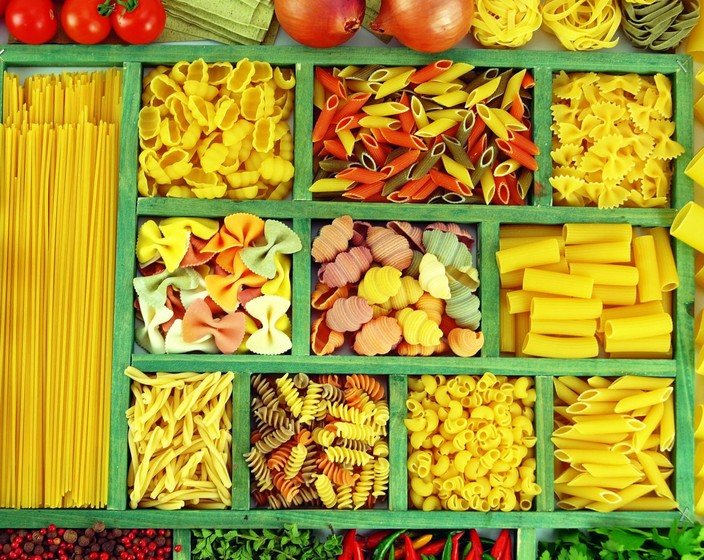
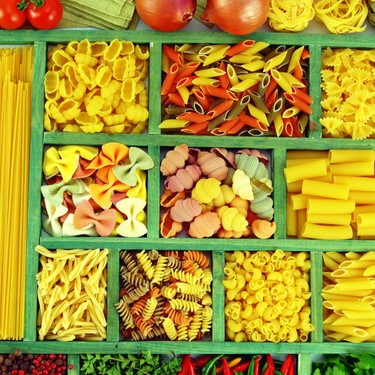


Everyone can agree that pasta is an easy delicious dish that allows endless experimentation. Depending on your cravings, you can match it with classic marinara or bolognese or get creative with flavorful creamy and cheesy sauces like alfredo or carbonara. And then there's always the nutty, rich pesto too!
The variety of pasta shapes in Italy is endless. Pasta isn’t just a food; it's an art form. There is a perfect shape to match your favorite sauce or filling and cooking method. But before you get overwhelmed with all the pasta options and delicious dishes to make with them, let’s break it all down.
We have categorized the most popular types of Italian pasta for you and matched them with the best possible pasta dishes. And then, sprinkled our pasta guide with some interesting facts about pasta names, origins, and meanings to make your daily rotini more fun.
Here is your only guide to pasta shapes and uses!

The most famous and beloved pasta worldwide is spaghetti. It reportedly originated in China but became popularized when Marco Polo brought it to Venice during his travels across Asia centuries ago!
Spaghetti is usually made from semolina flour and water and shaped into 10-12 inches long thin strands. This type of pasta has a signature chewy texture combined with enough elasticity, so they don't break when cooked al dente - just right for your average weeknight dinner.
You can find variations of spaghetti called:
Spaghettini - a thinner more delicate type of pasta often used in seafood dishes.
Spaghettoni - a bit thicker in diameter than spaghetti.
Spaghetti alla chitarra - unlike regular spaghetti, made using wheat flour and water, spaghetti alla chitarra is an egg pasta. It gets its name from the pasta machine called “chitarra” (meaning “guitar” in Italian), which makes this type of spaghetti.
Spaghetti pairs well with many different sauces, meat, seafood, and vegetables. It is most commonly served with tomato-based sauces like marinara or bolognese but tastes just as delicious paired with cream-based sauces.
There’s no shortage of ideas when it comes to spaghetti recipes, here are just a few of our favorites.
Capellini is also known as Angel Hair Pasta; in Italian, “capellini” means “fine hair.”
This type of long pasta is thinner than spaghettini and even more refined and delicate.
It pairs well with light tomato sauces, soups, consommés, or dairy-based sauces. Be careful not to overcook this fine pasta; it only takes about 3 minutes to cook capellini al dente.
You can easily substitute capellini for regular spaghetti in any recipe and vice versa.

Bucatini is another long type of pasta; it translates to “hollow straws.” It is a thicker version of spaghetti with a hole running through the middle.
Bucatini got its name from the Italian “buco,” meaning "hole." In Napoli, it is also known as Perciatelli, where “perciato” means "pierced." Bucatini and Perciatelli are essentially the same types of pasta.
Its unique consistency makes bucatini the perfect vessel for the most delectable sauces. When slightly undercooked, it is often used to stuff vegetables like bell peppers, tomatoes, or eggplants.
According to Neapolitan tradition, bucatini or perciatelli work well in unexpected combinations. It pairs well with sardines, pecorino cheese, fish sauce, or ricotta.
Linguine is a long flattened pasta type from the North-Western regions of Liguria and Genoa. The name linguine means “little tongues” in Italian.
Linguine is traditionally paired with pesto sauce , but also goes well with tomato-based sauces and fish.

Fettucine is perhaps the most popular long flat strand-like egg pasta type. It means “little ribbons” in Italian and is most common in Roman and Tuscan cuisine.
Traditionally fettuccine is best with creamy, dairy-based sauces like classic alfredo sauce. It also pairs well with ragu-type sauces and dishes where a protein like chicken or shrimp are the main ingredients.
Tagliatelle is essentially a wider, thinner fettuccine at about a quarter-inch thick. This ribbon-like egg pasta is usually sold as fresh, unlike fettuccine.
Tagliatelle is known for its ability to capture every drop of sauce. It pairs well with thicker meaty sauces and is the number one choice of pasta to serve with meatballs in Italy.

Pappardelle is long, flat, and broad ribbons of egg pasta; it’s similar to tagliatelle and fettuccine but much wider. This pasta is originally from Tuscany - a region known for rich, hearty, meaty sauces.
Pappardelle gets its name from the Italian “pappare,” which means “to gobble up.” Its somewhat rough texture and large surface area make it the perfect pasta for ragus and sauces, featuring robust flavors of portobello mushrooms or game meats.
It was created in honor of Princess Mafalda of Savoy, hence its other name, Reginette (meaning “little queens”).
Mafaldine is a long flat pasta with wavy edges on both sides originating in Naples. Its shape makes it almost impossible for any sauce to drop off.
Neapolitans like serving mafaldine with light simple sauces; it is also often used in baked pasta dishes.
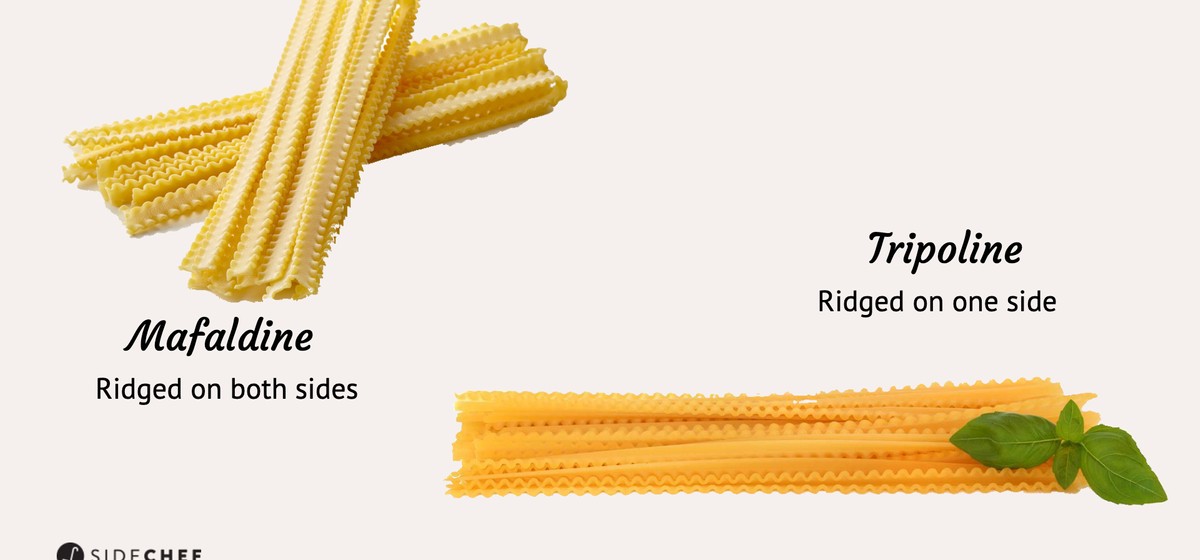
Conchiglie is Italian for what we know as shell pasta. Conchiglie pasta is very versatile. The shell's ridged exterior and hollow pockets mean that when you stir in the sauce, it will fill up every crevice inside and stick to the surface.
This pasta shape comes in 3 sizes:
There are countless recipes using conchiglie shells. Here are just some of our favorites for your inspiration.
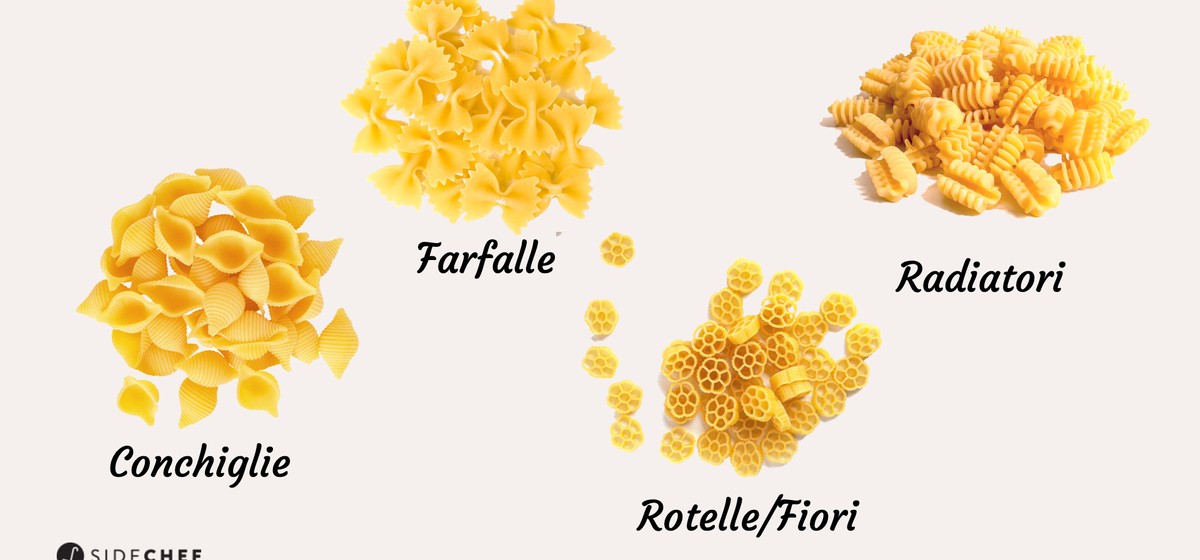
Farfalle means “butterfly” in Italy, which perfectly represents the shape of this pasta type.
Farfalle is an excellent vessel for thick and creamy tomato sauce, cream sauce, or simple lemon-garlic sauce. It is also a great pasta choice for cold salad dishes paired with vegetables like tomatoes, cucumbers, olives, and cheeses like feta or mozzarella.

Fusilli is one of the most universal pasta shapes out there. The small nooks and crannies of the helix shape can hold on to any kind of sauce. You can choose fusilli for hot pasta dishes with light or meaty sauce, bake it or make a pasta salad. Fusilli can do it all.
Fiori means “flowers” in Italian. This type of extruded pasta resembles a flower and is great for capturing all kinds of sauces, meat, vegetables, or seafood.
Both fiori and rotelle pasta add more of a decorative element to various dishes.
Radiatori pasta resembles a radiator in its shape. This pasta is often used in the same dishes as rotelle, fiori, or fusilli, as its shape is perfect for capturing thick, hearty sauces.
You can also use radiatori in soup, casseroles, or pasta bakes.
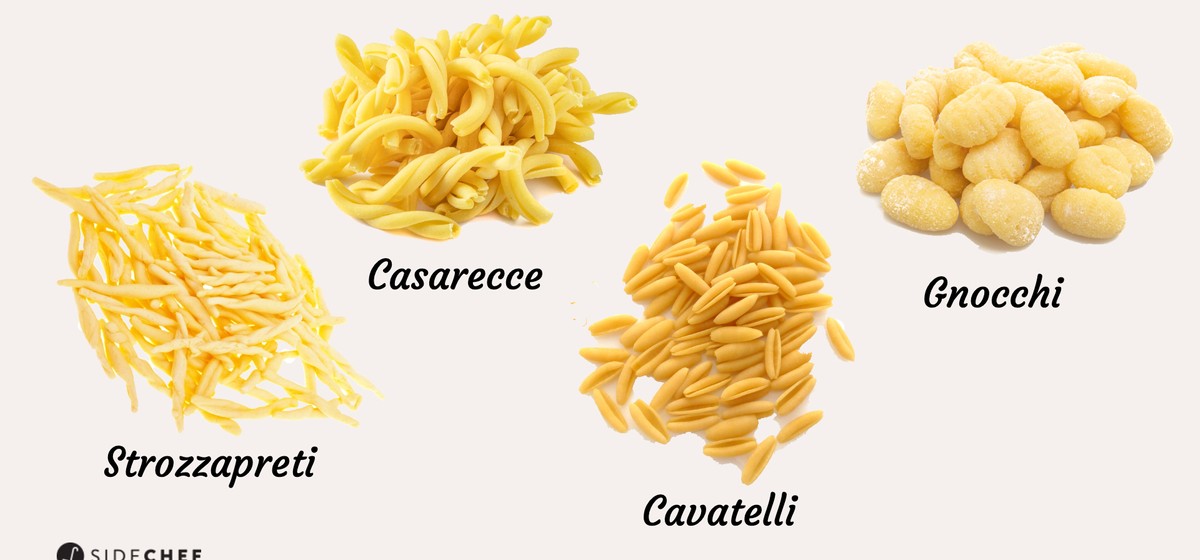
Strozzapreti is another type of pasta that perfectly delivers any kind of sauce directly to your taste buds. This recipe varies from region to region, but it pairs well with prosciutto, asparagus, and creamy or chunky sauces.
Strozzapreti pasta is also interesting because of the many origin stories behind its name.
Strozzapreti translates directly to “priest strangler”. There are several versions behind this morbid pasta variety:
One unmistakable conclusion from all strozzapreti origin stories: priests were not particularly popular during the time.
Casarecce is a traditional short pasta type from Sicily. It is almost identical to strozzapreti, with the only difference being its length. Casarecce is slightly shorter.
Pasta Alla Norma is a great recipe for either strozzapreti or casarecce.
Cavatelli pasta looks very similar to gnocchi (which some don’t consider pasta). Even though it’s easy to confuse these two because of their appearance, they taste entirely different.
Cavatelli is made from durum wheat semolina flour and water, while gnocchi is traditionally made using potatoes and flour mix.
This type of pasta is perfect for baked pasta dishes and casseroles.
What is gnocchi exactly is a question many culinary enthusiasts still argue. Gnocchi may not check all the requirements for being a pasta type, as it is made mainly of potatoes, but every pasta lover must try this ambiguous Italian invention nonetheless.
Gnocchi can be classified as a potato dumpling. But it pairs beautifully with many kinds of sauces and toppings you’d usually use with pasta.
Here’s an easy homemade gnocchi recipe you should try and some delicious recipe ideas using gnocchi
Rigatoni is a pasta type - short wide tubes of pasta ridged on the outside but smooth on the inside.
It is perfect for bakes and chunky sauces. There are several pasta shapes similar to rigatoni.
Campanelle is a delicate pasta with petal-like edges and a hollow center, perfect for holding delicious sauces and dressings. Its unique bell shape also adds a decorative element to a dish and makes it stand out from the rest.
Garganelli is a type of pasta that is short and ridged. It is made by wrapping squares of fresh egg pasta dough around a wooden stick, then rolling them across a ridged surface to form their characteristic grooves.

Similar to what many of us know as “macaroni,” Italian maccheroni is a short, tubelike pasta often with ridges that are a bit larger than the one used in boxed mac and cheese.
Smooth, slightly curved macaroni is often referred to as the elbow macaroni we know and love. The best use for this type of pasta is obvious - mac and cheese. But don’t be afraid to try it with other creamy, chunky sauces.
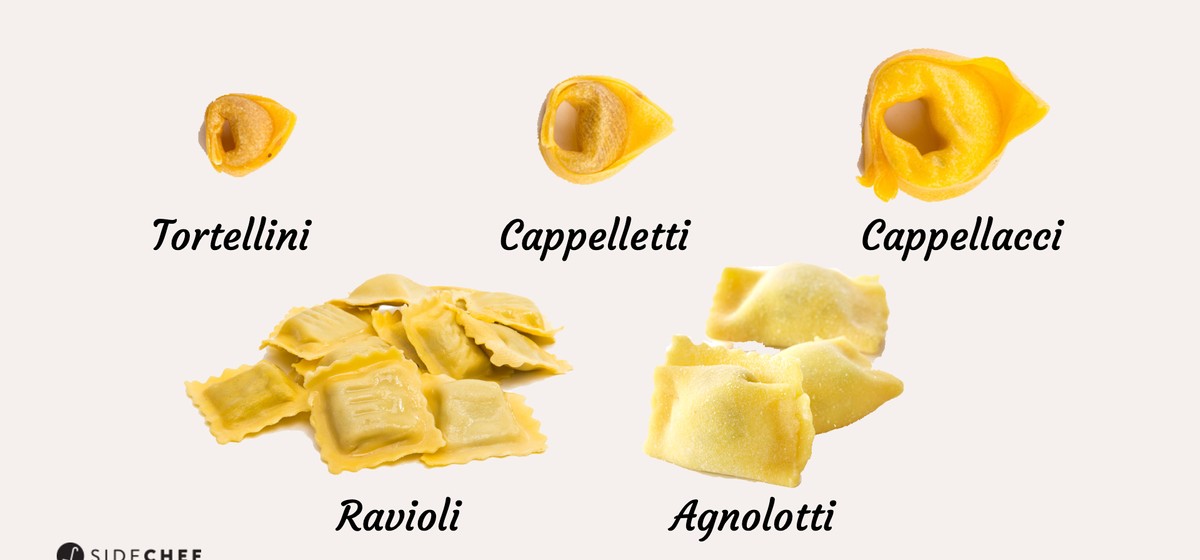
Tortellini are a type of pasta originally from the Italian region of Emilia. They are made by folding a round piece of dough over a filling, twisting the two ends together, and pinning the pasta into a round dumpling-like shape.
Traditionally, they are stuffed with meat (pork loin, prosciutto, mortadella), cheese, and eggs and served in soup or sauce.
Several other types of pasta are similar to tortellini: tortelloni, cappelletti, and cappellacci.
Ravioli is another popular type of stuffed Italian pasta. Ravioli features a filling sealed between two thin squares of egg pasta. The filling typically consists of cheese such as ricotta, leafy greens, meat, or mushrooms.
The dish's name comes from the Italian word "ravvolgere," which means to wrap or wind. Ravioli are typically square, but there are many different varieties.

Cannelloni is a type of pasta that is essentially a sheet rolled into a tube. It is typically filled with stuffing, topped with a sauce, and then baked.
Any stuffing that is good for ravioli or tortellini pairs well with cannelloni. But, because cannelloni is much larger than ravioli or tortellini, it is better to use meaty ingredients like porcini mushrooms or shrimp for better texture.

Lasagne is one of the oldest types of pasta. It's made of wide, flat sheets that are used for baking in the oven. The sheets are put between layers of sauce and different additional ingredients to make a dish known by the same name.
The dish is usually topped with grated cheese, and it's cut into single-serving square portions when it's done baking.
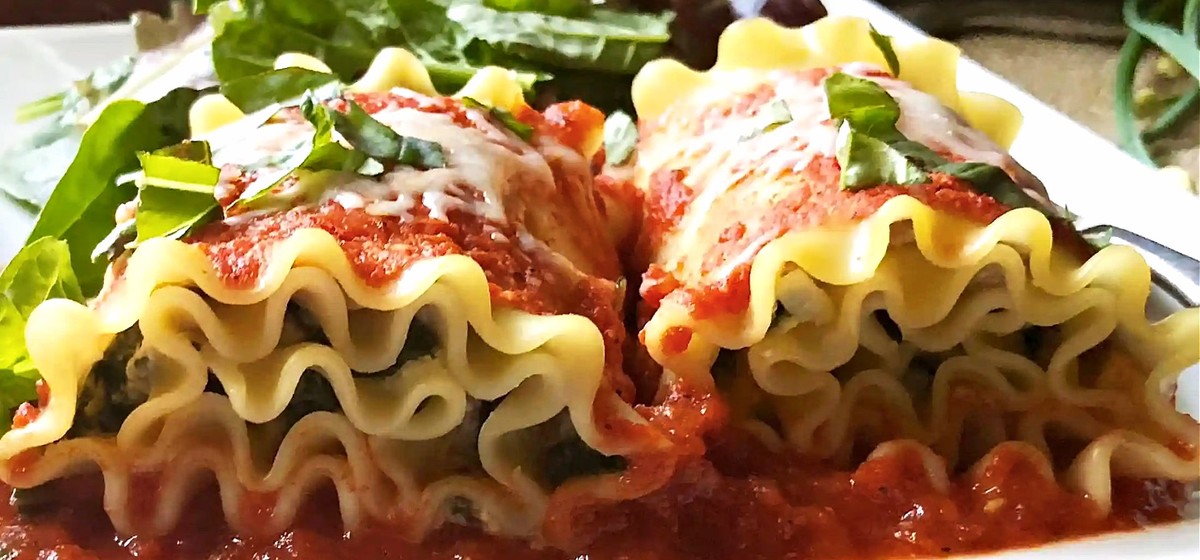
Pastina is the smallest type of pasta. In Italy, it is often served to kids.
Pastina is a good filler for soups. You can also find it in salads and dishes that otherwise use rice (orzo pasta is perfect for those).
There are many different shapes of pastina, but generally, pasta smaller than 1/4 inch is considered to be pastina. The shape of pastina can be stars, tubes, tiny macaroni, rings, or shells.
Almost every type of short pasta has its mini pastina version.
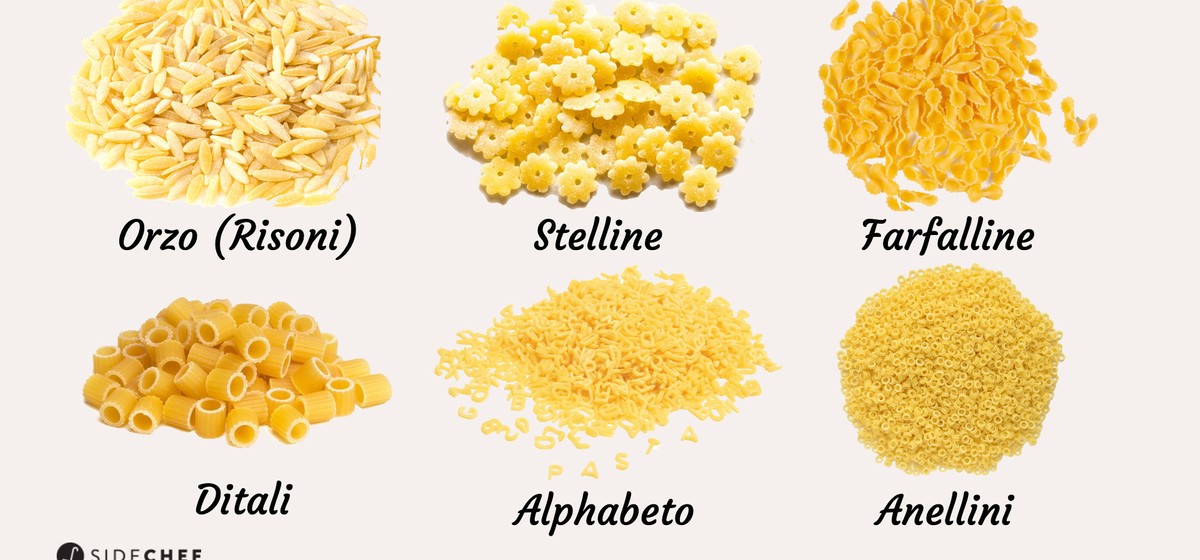
Pasta is one of those dishes that everyone seems to love. It’s versatile, affordable, and easy to make. Now that you know all there is to know about pasta, it’s time to get cooking! Explore our recipes and get groceries in one click – your taste buds will thank you for it.